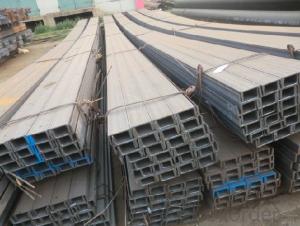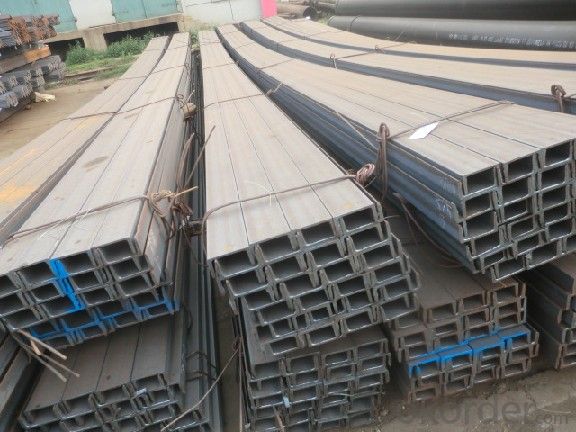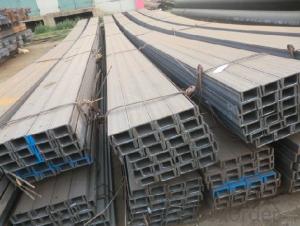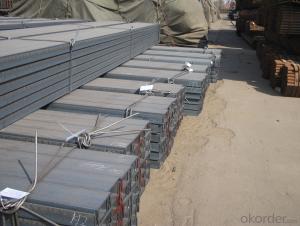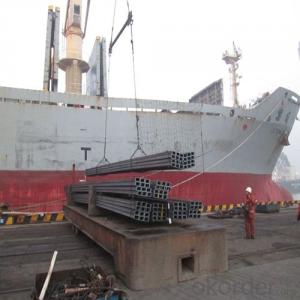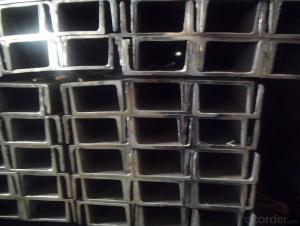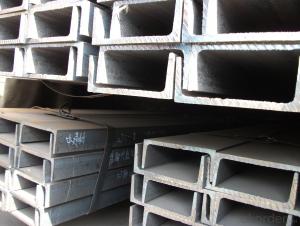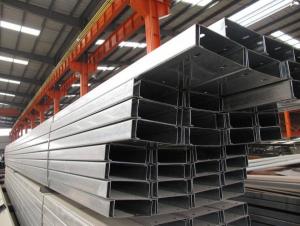Hot Rolled Steel U-Cnannel/UPN/JIS U-Channel/GB U-Channel
- Loading Port:
- Tianjin
- Payment Terms:
- TT OR LC
- Min Order Qty:
- 50 m.t.
- Supply Capability:
- 20000 m.t./month
OKorder Service Pledge
OKorder Financial Service
You Might Also Like
Specification
Product Description:
OKorder is offering Hot Rolled Steel U-Cnannel/UPN/JIS U-Channel/GB U-Channel at great prices with worldwide shipping. Our supplier is a world-class manufacturer of steel, with our products utilized the world over. OKorder annually supplies products to European, North American and Asian markets. We provide quotations within 24 hours of receiving an inquiry and guarantee competitive prices.
Product Applications:
Hot Rolled Steel U-Cnannel/UPN/JIS U-Channel/GB U-Channel are ideal for structural applications and are widely used in the construction of buildings and bridges, and the manufacturing, petrochemical, and transportation industries.
Product Advantages:
OKorder's Hot Rolled Steel U-Cnannel/UPN/JIS U-Channel/GB U-Channel are durable, strong, and resist corrosion.
Main Product Features:
· Premium quality
· Prompt delivery & seaworthy packing (30 days after receiving deposit)
· Corrosion resistance
· Can be recycled and reused
· Mill test certification
· Professional Service
· Competitive pricing
Product Specifications:
JIS U CHANNEL | Standard | Sectional | Dimension |
| Mass: |
| (mm) | (mm) | (mm) | (mm) |
|
50x25 | 50 | 25 | 3.0 | 6.00 | 2.37 |
75X40 | 75 | 40 | 3.8 | 7.00 | 5.30 |
75X40 | 75 | 40 | 4.0 | 7.00 | 5.60 |
75X40 | 75 | 40 | 4.5 | 7.00 | 5.85 |
75X40 | 75 | 40 | 5.0 | 7.00 | 6.92 |
|
|
|
|
|
|
100X50 | 100 | 50 | 3.8 | 6.00 | 7.30 |
100X50 | 100 | 50 | 4.2 | 6.00 | 8.03 |
100X50 | 100 | 50 | 4.5 | 7.50 | 8.97 |
100X50 | 100 | 50 | 5.0 | 7.50 | 9.36 |
|
|
|
|
|
|
125X65 | 125 | 65 | 5.2 | 6.80 | 11.66 |
125X65 | 125 | 65 | 5.3 | 6.80 | 12.17 |
125X65 | 125 | 65 | 5.5 | 8.00 | 12.91 |
125X65 | 125 | 65 | 6.0 | 8.00 | 13.40 |
|
|
|
|
|
|
150x75 | 150 | 75 | 5.5 | 7.30 | 14.66 |
150x75 | 150 | 75 | 5.7 | 10.00 | 16.71 |
150x75 | 150 | 75 | 6.0 | 10.00 | 17.90 |
150x75 | 150 | 75 | 6.5 | 10.00 | 18.60 |
150x75 | 150 | 75 | 6.5 | 10.00 | 24.00 |
|
|
|
|
|
|
200X80 | 200 | 80 | 7.5 | 11.00 | 24.60 |
Package & Delivery of JIS U Channel Steel:
1.The JIS u channel steel will be packed in bundle with steel wire at each end of every bundle and color marking in order to help the customer to recognize his goods more easily at sight.
2. And the channel steel could be loaded into 20ft or 40ft container, or by bulk cargo.If the weight of each bundle reaches more than 3.5 mt, the loading by break bulk cargo should be choosed.When the weight of each bundle reaches less than 3mt, the loading by container should be choosed.
3.As for the transportaion from mill to loading port, the truck will be usually used. And the maximum quantity for each truck is 40mt.
4.All in all, we could do in accordance with customer's request.
FAQ:
Q1: Why buy Materials & Equipment from OKorder.com?
A1: All products offered byOKorder.com are carefully selected from China's most reliable manufacturing enterprises. Through its ISO certifications, OKorder.com adheres to the highest standards and a commitment to supply chain safety and customer satisfaction.
Q2: How do we guarantee the quality of our products?
A2: We have established an advanced quality management system which conducts strict quality tests at every step, from raw materials to the final product. At the same time, we provide extensive follow-up service assurances as required.
Q3: How soon can we receive the product after purchase?
A3: Within three days of placing an order, we will begin production. The specific shipping date is dependent upon international and government factors, but is typically 7 to 10 workdays.
Q4: What makes stainless steel stainless?
A4: Stainless steel must contain at least 10.5 % chromium. It is this element that reacts with the oxygen in the air to form a complex chrome-oxide surface layer that is invisible but strong enough to prevent further oxygen from "staining" (rusting) the surface. Higher levels of chromium and the addition of other alloying elements such as nickel and molybdenum enhance this surface layer and improve the corrosion resistance of the stainless material.
Q5: Can stainless steel rust?
A5: Stainless does not "rust" as you think of regular steel rusting with a red oxide on the surface that flakes off. If you see red rust it is probably due to some iron particles that have contaminated the surface of the stainless steel and it is these iron particles that are rusting. Look at the source of the rusting and see if you can remove it from the surface.
Images:
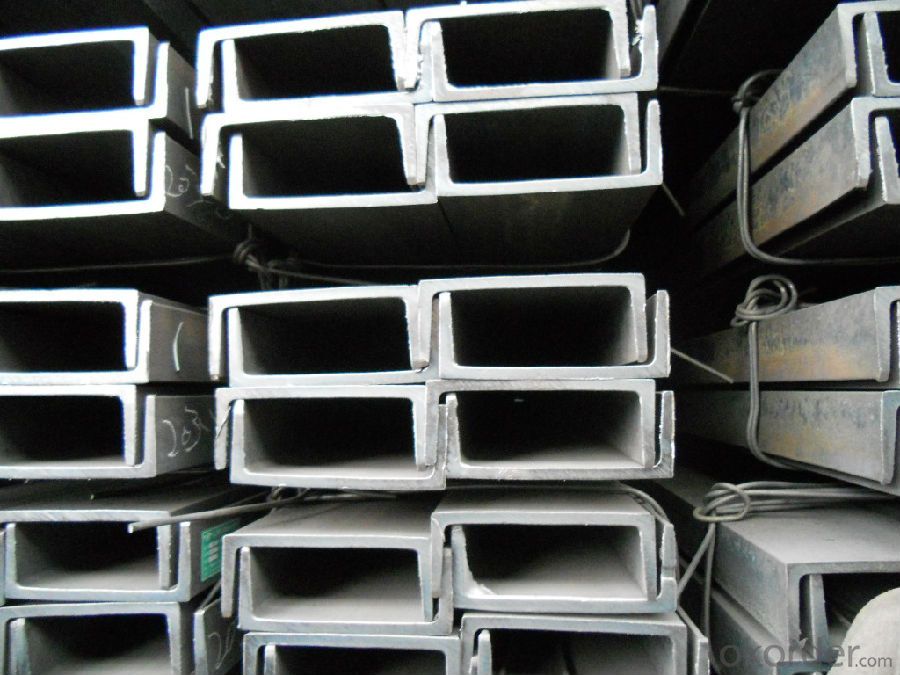
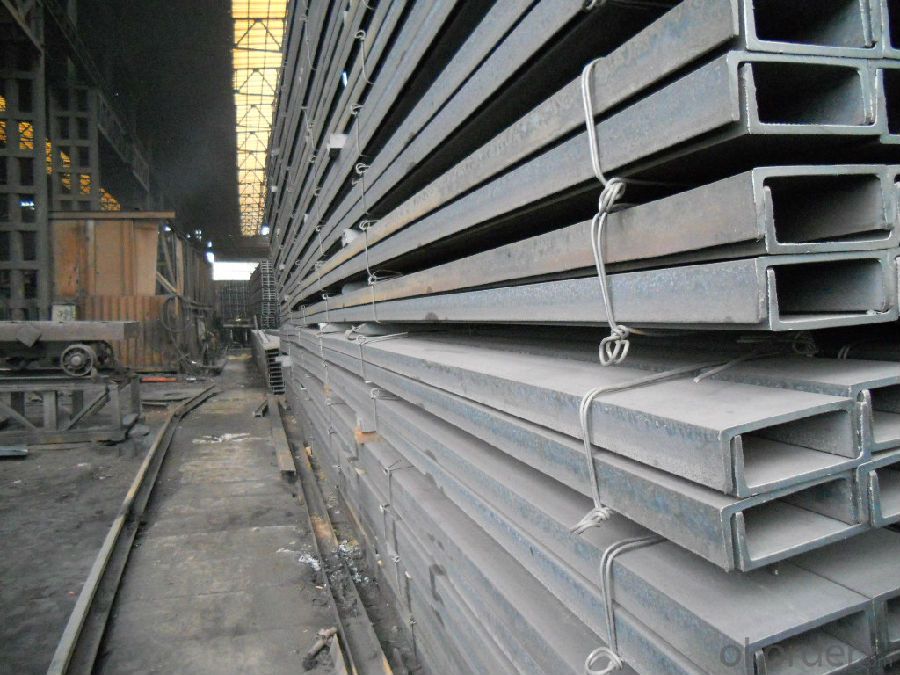
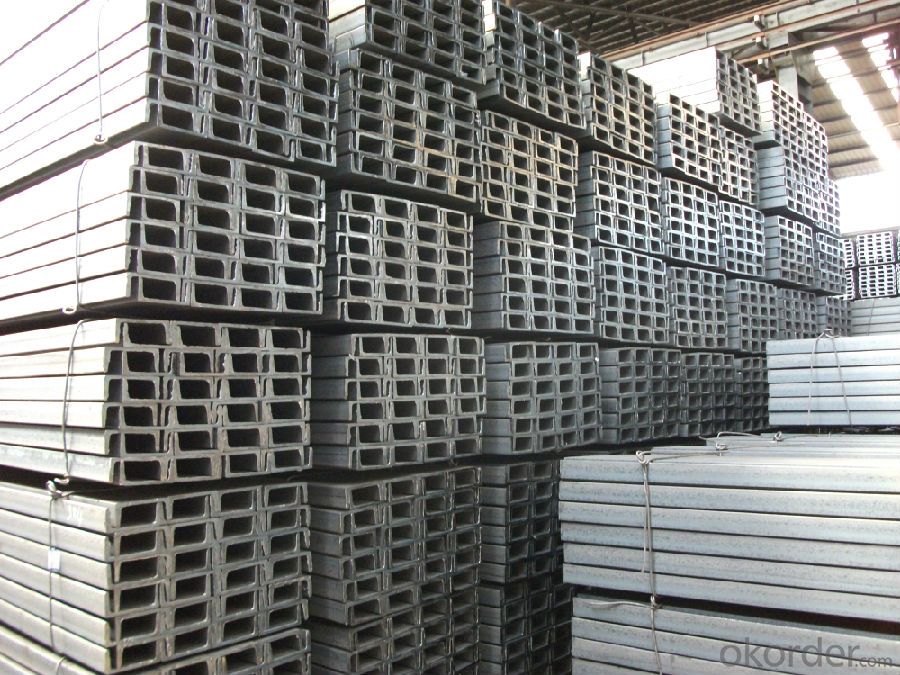
- Q: Can steel channels be used in shipbuilding?
- Indeed, shipbuilding incorporates the utilization of steel channels. Due to their robustness, longevity, and adaptability, steel channels are widely employed in ship construction. These channels serve as a reliable source of structural support and find application in various tasks such as framing, stiffening, and reinforcing different sections of the ship's hull and superstructure. Specifically designed to endure the adverse conditions encountered at sea, including wave impact, corrosion, and extreme temperatures, steel channels prove their resilience. Additionally, their weldability facilitates efficient assembly and repair procedures. In summary, steel channels constitute a vital element in shipbuilding, playing a critical role in upholding the vessel's strength and integrity.
- Q: What are the different methods for reinforcing steel channels?
- There are multiple ways to reinforce steel channels, depending on their specific requirements and applications. Some commonly used methods include: 1. Welding: Reinforcing steel channels often involves attaching additional steel plates or bars to the existing channel using an electric arc to generate high heat. This method creates a strong bond and ensures structural integrity. 2. Bolting: Another method for reinforcement is to attach extra steel plates or bars to the channel using bolts and nuts. This approach is relatively easier to implement and allows for easy removal or adjustment if necessary. 3. Adhesive bonding: Industrial-grade adhesives are utilized in adhesive bonding to bond extra steel plates or bars to the steel channel. This approach provides a strong bond and is commonly used when welding or bolting may not be feasible or desired. 4. Fiber reinforced polymers (FRP): FRP composites, such as carbon fiber or fiberglass, can be used to strengthen steel channels. These materials are lightweight, high-strength, and corrosion-resistant, making them suitable for reinforcing channels in corrosive environments or where weight is a concern. 5. Shotcreting: This method involves spraying a mixture of cement, sand, and reinforcing fibers onto the surface of the steel channel. The result is a layer of reinforced concrete that enhances the strength and durability of the channel. 6. Encasement: Sometimes, steel channels are reinforced by encasing them in concrete. This technique involves pouring concrete around the channel, creating a composite structure that combines the strength of both materials. 7. Pre-stressing: Pre-stressing refers to applying tension to the steel channel before it is loaded. This can be achieved using pre-stressed steel strands or bars, which are anchored at the ends of the channel. The pre-stressing force helps counteract the tensile forces that the channel may experience during use. It's important to consider factors such as load requirements, environmental conditions, cost, and feasibility when selecting the appropriate method for reinforcing steel channels. Consulting with a structural engineer or expert is recommended to ensure the chosen method meets the specific needs of the application.
- Q: Can steel channels be used in industrial buildings?
- Industrial buildings can utilize steel channels for various purposes. Known as C-channels or U-channels, steel channels are steel structural members that come in a C or U shape. They are commonly employed in construction and industrial settings due to their strength and adaptability. Within industrial buildings, steel channels find use in multiple ways. They often serve as support beams or columns, providing structural stability and the ability to bear heavy loads. By effectively distributing the weight of machinery, equipment, and materials, steel channels meet the demands of industrial applications where robust and durable structural components are necessary. Moreover, steel channels can be applied to frame walls, roofs, and floors in industrial buildings. They can be conveniently connected and welded together to form rigid and stable frames. Given their ability to be cut and shaped according to specific requirements and specifications, steel channels offer design flexibility. In addition, steel channels demonstrate excellent resistance to corrosion, making them a suitable choice for industrial environments exposed to moisture, chemicals, or other harsh conditions. With a long lifespan and low maintenance needs, steel channels prove advantageous for industrial buildings that undergo heavy use and demanding operations. In summary, the strength, versatility, and corrosion resistance of steel channels make them a popular choice in industrial buildings. They provide structural stability, support heavy loads, and offer design flexibility. Whether utilized as support beams, framing components, or in other applications, steel channels effectively meet the requirements of industrial buildings.
- Q: What are the specifications for steel channels?
- Steel channels possess specific specifications concerning their dimensions, material composition, and mechanical properties. The specifications governing steel channels are subject to variation based on industry standards and requirements. To begin with, it is vital to consider the dimensions of steel channels as a significant specification. These dimensions encompass the channel's height, width, and thickness. Steel channels are typically available in a range of sizes, with standard measurements such as C3x4.1 or C6x10.5. The first figure denotes the channel's height, while the second figure represents the weight per linear foot. Additionally, the material composition of steel channels constitutes a critical specification. Steel channels are manufactured using various types of steel, including carbon steel, alloy steel, or stainless steel. The choice of steel grade employed is contingent upon the intended application and desired strength and corrosion resistance properties. Moreover, steel channels exhibit mechanical properties that necessitate specification. These properties comprise the yield strength, tensile strength, and elongation of the steel. The mechanical properties determine the steel channel's load-bearing capacity and durability. Different applications may necessitate steel channels with specific mechanical properties to ensure structural integrity and safety. Furthermore, surface finish and coating specifications may also hold importance for steel channels. Steel channels can be supplied with diverse surface finishes, such as hot-rolled, cold-rolled, or galvanized finishes. Coatings, such as zinc or paint, can be applied to enhance corrosion resistance and aesthetics. In conclusion, the specifications governing steel channels encompass dimensions, material composition, mechanical properties, surface finish, and coating. These specifications are imperative for ensuring the appropriate selection and utilization of steel channels in various applications, including construction, manufacturing, and infrastructure projects.
- Q: Can steel channels be used in the construction of fencing or barriers?
- Yes, steel channels can be used in the construction of fencing or barriers. Steel channels are versatile and strong structural components that can provide the necessary support and stability required for fencing and barrier systems. They can be used to create a framework for the fence or barrier, providing a solid structure to hold the fencing material or panels in place. Steel channels are durable and resistant to weather and corrosion, making them suitable for outdoor applications. They can be easily customized to fit specific design requirements and are available in various sizes and thicknesses to accommodate different fencing or barrier needs. Additionally, steel channels can be welded, bolted, or secured using other fastening methods, ensuring a secure and long-lasting fence or barrier system.
- Q: What are the different material specifications for steel channels?
- There are various material specifications for steel channels, such as the American Standard Channels (C-shape), which are designated by their height and weight per foot. Another specification is the European Standard Channels (U-shape), which are identified by their dimensions and weight per meter. Additionally, steel channels can be produced in different grades, such as A36, A572, and A588, which determine their mechanical properties and suitability for specific applications.
- Q: Are steel channels suitable for industrial applications?
- Yes, steel channels are highly suitable for industrial applications. Steel channels are made from high-quality steel and are known for their strength, durability, and versatility. They can withstand heavy loads and provide structural support in various industrial settings. Steel channels are commonly used in the construction of buildings, bridges, warehouses, and factories. They are also extensively utilized in the manufacturing and transportation industries for the production of machinery, equipment, and vehicles. Moreover, steel channels can be easily customized to meet specific requirements and can be fabricated in various sizes, shapes, and thicknesses. Due to their excellent properties and adaptability, steel channels are widely regarded as a reliable and cost-effective solution for industrial applications.
- Q: How is a steel channel different from a steel beam?
- A steel channel and a steel beam are both structural steel components used in construction, but they have distinct differences in their shape and application. Firstly, a steel channel, also known as a C-channel or U-channel, is shaped like a rectangular prism with two flanges (horizontal sides) and a web (vertical center). The flanges are usually narrower than the web. This shape allows the channel to be lightweight, yet strong, making it suitable for various applications such as framing, supports, and bracing. The flanges also provide additional rigidity and stability, making channels ideal for use in load-bearing structures. On the other hand, a steel beam, also referred to as an I-beam or H-beam, has a distinctive "I" or "H" shape. It consists of two horizontal flanges connected by a vertical web in the center. The flanges are typically wider than those of a channel, resulting in a greater load-bearing capacity. Beams are commonly used in structural applications where strength and stability are crucial, such as supporting heavy loads or spanning large distances. Due to their design, beams distribute weight evenly along their length, making them highly efficient in resisting bending and shearing forces. In summary, the main difference between a steel channel and a steel beam lies in their shape and purpose. Channels are lightweight and primarily used for framing and bracing, while beams are heavier and designed for load-bearing applications that require superior strength and stability.
- Q: How do steel channels contribute to the overall sustainability of a construction project?
- Steel channels contribute to the overall sustainability of a construction project by providing strength and durability to the structure. As steel channels can be recycled and reused, they help reduce the demand for new materials and minimize waste. Additionally, their long lifespan and resistance to corrosion reduce the need for frequent replacements, making them a sustainable choice for construction projects.
- Q: Can steel channels be used in the chemical manufacturing industry?
- Yes, steel channels can be used in the chemical manufacturing industry. Steel channels provide structural support and can be used in various applications such as building chemical storage tanks, platforms, walkways, and support structures for equipment and piping systems. Steel is known for its durability, strength, and corrosion resistance, making it suitable for chemical environments where exposure to corrosive substances and high temperatures is common. Additionally, steel channels can be customized and fabricated to meet specific design requirements, offering flexibility in construction and installation. Overall, steel channels are a reliable and versatile choice for the chemical manufacturing industry.
Send your message to us
Hot Rolled Steel U-Cnannel/UPN/JIS U-Channel/GB U-Channel
- Loading Port:
- Tianjin
- Payment Terms:
- TT OR LC
- Min Order Qty:
- 50 m.t.
- Supply Capability:
- 20000 m.t./month
OKorder Service Pledge
OKorder Financial Service
Similar products
Hot products
Hot Searches
Related keywords
